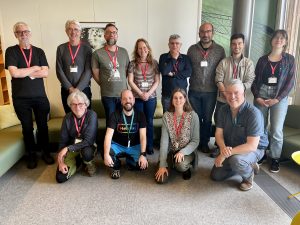
A new EU project launched this month will evaluate changes in bird abundance and distributions in Europe, while developing new tools to meet conservation targets for 2030 such as the Global Biodiversity Framework.
The kick-off meeting for a new international European bird conservation project was hosted on 10-11 May by the Norwegian Institute for Nature Research (NINA) in Trondheim, Norway.
The two goals of the collaborative project SPEAR (“Scenarios for Protecting European Avian Redistributions”) are to evaluate changes in bird abundance and distributions in Europe, and to develop improved policy tools to meet new targets set under the EU Biodiversity Strategy 2030 and the Kunming-Montreal Global Biodiversity Framework under the United Nations’ Convention on Biological Diversity. SPEAR is a 1.6M Euro project funded by the BiodivProtect call from EU Biodiversa+.
Assessing different aspects of avian conservation
SPEAR will identify gaps in the current European land and marine protected area networks for the conservation for threatened species and critical habitats. It will also assess the resilience of the protected area networks under different future scenarios for environmental change.
SPEAR will develop best practice guidelines to inform managers of protected areas about improving implementation of conservation actions to mitigate adverse impacts of climate change on birds. SPEAR will also focus on huntable waterbird species, and the regulations needed to ensure sustainable harvest under climate change.
Lastly, SPEAR will evaluate the benefits of created and restored wetlands for biodiversity, including their recreational value, the scientific results from which will guide development of best practice guidelines for future wetland restoration projects.
Contributing to a new biodiversity conservation strategy
“SPEAR will generate new knowledge to contribute to European decision-making regarding international conservation policy.
Our strong team of researchers and partners will steer the project towards producing policy relevant outcomes that can contribute, in collaboration with other international initiatives, to the implementation of the new EU Biodiversity Strategy goals for 2030 and the UN’s Convention on Biological Diversity” – Diego Pavón-Jordán, Researcher at NINA and Co-coordinator of SPEAR.
Collaboration across borders in a strong international consortium
Iben Hove Sørensen, Deputy President of the CIC Applied Science Division and wildlife biologist, is taking part in the project as a member of the SPEAR team.
The team comprises an international consortium of scientists from eight research institutions in Finland, Sweden, Norway, Denmark, United Kingdom, Switzerland, and Spain, as well as six conservation groups, including the secretariats of the Convention on Migratory Species (CMS) and the African-Eurasian Migratory Waterbird Agreement (AEWA) – both affiliated to the United Nations Environment Programme (UNEP) – Wetlands International, Stichting BirdLife Europe, the Danish Hunters’ Association, and the European Land Conservation Network (Eurosite).
Representatives participated in the kick-off meeting to determine priorities and plan research activities for the 3-year project (2023-2025). Collaboration between scientists, conservation partners and stakeholders will ensure a strong knowledge base that will inform the policy processes much needed for effective biodiversity conservation in Europe.
Contact details
diego.pavon-jordan@nina.no (+47 40485250)
brett.sandercock@nina.no (+47 45216480)
